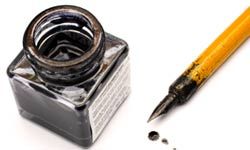Finding a felt tip ink or Indian ink stain on a household surface is enough to make even the coolest host flip their lid. Learn stain removal techniques while maintaining the grace and style even Martha would admire.
The first step in removing ink stains is to identify the stained material.
Advertisement
Below are the most common types of materials that can become ink-stained, with steps on how to remove ink from each:
- Non-washable fibers such as Acetate, Burlap, Fiberglass, Rayon, Rope, Silk, Triacetate or Wool
- Other fabrics such as Acrylic Fabric, Cotton, Linen or Modacrylic
- Hard surfaces such as Acrylic Plastic, Aluminum, Asphalt, Bamboo, Cane, Ceramic Glass/Tile, Enamel, Glass, Paint (flat or gloss), Plexiglas, Polyurethane, Porcelain Dishes, Porcelain Fixtures, Stainless Steel, Vinyl Clothing or Vinyl Wallcovering
- Alabaster or Marble
- Stone surfaces such as Bluestone, Brick, Concrete Flagstone, Granite, Limestone, Masonry Tile, Sandstone, Slate, Terrazzo
- Carpet (synthetic or wool)
- Porous surfaces such as Cork, Linoleum or Vinyl Tile
- Special fabrics such as Felt, Fur (natural or synthetic), Leather or Suede
- Grout
- Synthetic fabrics such as Nylon, Olefin, Polyester or Spandex
- Wallpaper
- Wood
Advertisement
